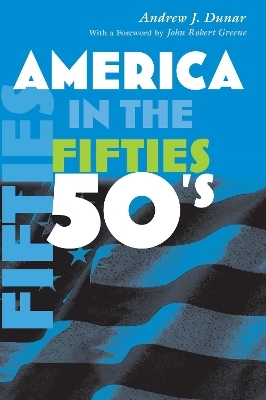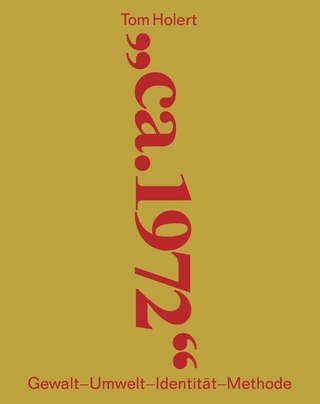
America in the Fifties
Seiten
2006
Syracuse University Press (Verlag)
978-0-8156-3128-6 (ISBN)
Syracuse University Press (Verlag)
978-0-8156-3128-6 (ISBN)
- Lieferbar (Termin unbekannt)
- Versandkostenfrei innerhalb Deutschlands
- Auch auf Rechnung
- Verfügbarkeit in der Filiale vor Ort prüfen
- Artikel merken
Shows how the issues confronted America in the late twentieth century have roots in the fifties, some apparent at the time, others only in retrospect: civil rights, environmentalism, the counterculture, and ""movements"" on behalf of women, Chicanos, and Native Americans. This book is useful for instructors of American history survey courses.
Blessed by a booming economy, the United States moved into the space age and the golden age of television in the 1950s. At the same time, the nation faced domestic and international divisions that would have far-reaching historical and political consequences. The 1950s evoke images of prosperity, suburbia, a smiling President Eisenhower, cars with elaborate tail fins, Elvis Presley, Marilyn Monroe, and the ""golden age"" of television - seemingly a simpler time in which the idealized family life of situation comedies had at least some basis in reality. A closer examination, however, recalls more threatening images: the hysteria of McCarthyism, the shadow of the atomic bomb, war in Korea, the Soviet threat manifested in the launch of Sputnik and the bombast of Nikita Khrushchev, and a clash over the integration of a high school in Little Rock. Andrew J. Dunar successfully shows how the issues confronted America in the late twentieth century have roots in the fifties, some apparent at the time, others only in retrospect: civil rights, environmentalism, the counterculture, and ""movements"" on behalf of women, Chicanos, and Native Americans. The rise of the ""beats,"" the continuing development of jazz, the emergence of rock 'n roll, and the art of Jackson Pollock reveal the decade to be less conformist than commonly portrayed. While the Cold War rivalry with the Soviet Union generated the most concern, Dunar skillfully illustrates how the rise of Nasser in Egypt, Castro in Cuba, and Communist regimes in North Korea, Vietnam, and China signaled new regional challenges to American power. This book will be ideal for instructors of American history survey courses at the high school and undergraduate levels.
Blessed by a booming economy, the United States moved into the space age and the golden age of television in the 1950s. At the same time, the nation faced domestic and international divisions that would have far-reaching historical and political consequences. The 1950s evoke images of prosperity, suburbia, a smiling President Eisenhower, cars with elaborate tail fins, Elvis Presley, Marilyn Monroe, and the ""golden age"" of television - seemingly a simpler time in which the idealized family life of situation comedies had at least some basis in reality. A closer examination, however, recalls more threatening images: the hysteria of McCarthyism, the shadow of the atomic bomb, war in Korea, the Soviet threat manifested in the launch of Sputnik and the bombast of Nikita Khrushchev, and a clash over the integration of a high school in Little Rock. Andrew J. Dunar successfully shows how the issues confronted America in the late twentieth century have roots in the fifties, some apparent at the time, others only in retrospect: civil rights, environmentalism, the counterculture, and ""movements"" on behalf of women, Chicanos, and Native Americans. The rise of the ""beats,"" the continuing development of jazz, the emergence of rock 'n roll, and the art of Jackson Pollock reveal the decade to be less conformist than commonly portrayed. While the Cold War rivalry with the Soviet Union generated the most concern, Dunar skillfully illustrates how the rise of Nasser in Egypt, Castro in Cuba, and Communist regimes in North Korea, Vietnam, and China signaled new regional challenges to American power. This book will be ideal for instructors of American history survey courses at the high school and undergraduate levels.
Andrew J. Dunar is chair of the Department of History at the University of Alabama at Huntsville. His books include The Truman Scandals and the Politics of Morality, and with Stephen P. Waring, Power to Explore: A History of Marshall Space Flight Center, 1960-1990, which won the History Book Award from the American Institute of Aeronautics and Astronautics (AIAA) in 2000.
| Erscheint lt. Verlag | 30.12.2006 |
|---|---|
| Reihe/Serie | America in the Twentieth Century |
| Zusatzinfo | 13 black and white illustrations |
| Verlagsort | New York |
| Sprache | englisch |
| Maße | 152 x 229 mm |
| Gewicht | 490 g |
| Themenwelt | Geschichte ► Allgemeine Geschichte ► Zeitgeschichte |
| Geisteswissenschaften ► Geschichte ► Regional- / Ländergeschichte | |
| Geschichte ► Teilgebiete der Geschichte ► Kulturgeschichte | |
| Sozialwissenschaften | |
| ISBN-10 | 0-8156-3128-6 / 0815631286 |
| ISBN-13 | 978-0-8156-3128-6 / 9780815631286 |
| Zustand | Neuware |
| Haben Sie eine Frage zum Produkt? |
Mehr entdecken
aus dem Bereich
aus dem Bereich
Gewalt, Umwelt, Identität, Methode
Buch | Softcover (2024)
Spector Books OHG (Verlag)
36,00 €
wie Freud im Kollektiv verschwand
Buch | Hardcover (2024)
Klett-Cotta (Verlag)
25,00 €


